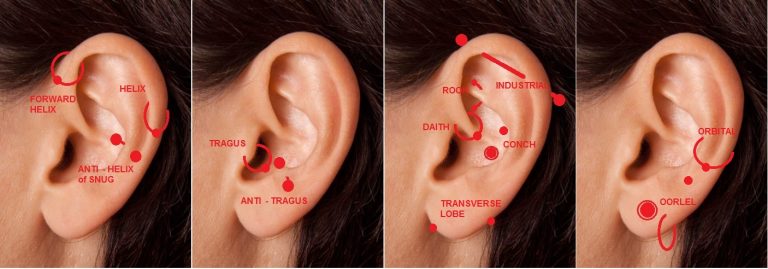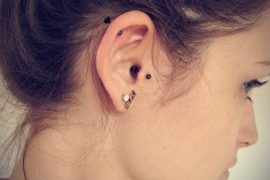LEAST PAINFUL EAR PIERCINGS IN ORDER
Least Painful Ear Piercings In Order
(From LEAST painful to MOST painful based on customer feedback)
- Ear Lobe
- Navel
- Lip
- Nostril
- Eyebrow
- Tongue
- Daith
- Helix
- Dermal Anchor
- Stretching
- Rook
- Conch
- Industrial
- Septum
- Nipple
- Genitals
Don’t forget guys, it’s all down to personal experience, so don’t be put off, if you really want to mod your bod, go for it!
If you want to know more about any type of piercing and how it’s done, check out the piercing bible for some great information! Or if you’re wandering what piercing would suit you best, have a browse at Pinterest for some seriously cool pierced inspo!
Please follow any aftercare instructions given to you by your piercer, but for even more piercing care tips, take a look at this NHS Piercing Aftercare article for some great advice on keeping that new mod clean.
Top 5 most painful piercings
Most painful piercings in order. How far would you go for that perfect piece of jewelry on your face or body? Here are the top 5 most painful piercings.
If you love body art, you probably know that in this case, the saying “Beauty is a pain” is true. The experience will depend on a number of factors. How you prepare for your piercing is important, even if you are scared or not. Fear makes everything look and feel much worse!
Not everyone has the same pain threshold.
Here is a ranking of painful piercings, from the least to the most painful.
1. Nose
Many people say that getting their nose done a lot of pain! Now, this is not my personal experience, but I think it depends on your pain threshold. Depending on the precise location, the needle goes through the skin or cartilage, and it is done fairly quickly.
The trickiest part is when full length of the needle has to be dragged through the hole because the bolt is on the end of the needle. There are a lot of nerves in your nose, all of which end up at the point, so it is believable that it hurts, and can also cause minor nerve damage. If a nerve is hit, you will experience some numbness, and the occasional “shooting” pain, but only experience it in a few hours.
2. Lip
Again, it depends on the location of the jewelry (labret, Monroe, lace), but lip piercings sometimes hurt too much. You will feel a first stab, and after that you should be fine.
A nerve can also be affected during this piercing, which can cause numbness and sharp pain, but there are no nerves in your lips that can cause serious or long-term problems.
3. Cartilage
A needle going through a harder surface will be more painful than a skin piercing. These do take an instant to perform longer, and a lot longer to heal. The first “hit” with the needle won’t hurt that much, but a healing cartilage will give you problems! If it’s your ear, you have to be super careful when brushing your hair and sleeping on that side.
4. Nipple
Both boys and girls say that getting their nipple hurt like hell. Just try to think the sensitivity – if it can reach arousal pleasure, it means that there are a lot of nerves that work their little asses out there. While they heal, it’s tricky because, unlike face piercings, you can’t leave them alone in the open. You have to wear clothes, and even the most simple cotton shirt, with no bra, will scour against the piercing. Have not really had the courage to have that one, and I probably never will.
5. Genital
Do you really need an explanation? The most sensitive part of our body that responds to the lightest touch will NOT want to get pierced with a needle! Both genders say that this is by far the most painful piercing, both done during and while healing.
Now, I’ve only done my nose, navel and cartilage, so I can say that none of them really hurt much while they put it in. It was just a first stab, and then it was done.
The piercing that gave me the most trouble was the cartilage, while healing it hurt a 3 on a scale of 1 to 10, and made sleeping on that side really hard!
Then again, there are people who have breezed by getting their nipples done and cried while they pierced their noses, so it really is an individual matter.
Let us know your most painful piercing experience!
Ear piercings in various forms
The most common forms of ear piercing is of course for wearing earrings or stud earrings. This type of ear piercing you all wear in the earlobe. But if you want to have an ear pierced then the possibilities are actually endless.
If you have never looked closely at your own ears, take a mirror. Almost every piece of ear, both the somewhat harder pieces (the cartilage) and the soft pieces are suitable for piercing. And you also have two of them.
Consider carefully which piercing you like before you have an ear pierced. The shape of your ear, your hairstyle and the face can determine the choice.
And you don’t necessarily have to go for a piercing, you can also stretch a pierced hole and place a Gauge. Since the ribs are very elastic, the stretching itself is not very painful. Note that a stretched hole in the ear lobe may no longer close.
Ear piercings type
The Helix and Tragus are the best known ear piercing. And these also have an “opposite” version, the so-called Anti-Helix (or called Snug) and Anti-Tragus. There are also inside and outside Conch, the Daith, Rook, Industrial, Orbital or Aericle, Rook and the Transverse Lobe piercing.

Helix
The Helix is one of the most popular piercing among the younger generation in the western world. The disadvantage is that this part of the soft cartilage around the ear has a greater chance of infection. Sometimes you see people who wear multiple Helix rings or connect a Helix with a chain to another ear piercing.
Tragus
This type of ear piercing became popular sometime after 2005. It is placed on the tragus , a small piece of cartilage over the ear canal. Putting is extremely painful because this part of the ear is thick and meaty. It can cause excessive pain and bleeding. The Tragus piercing also needs a long time to heal. If you wear a lot of earphones or in-ear headphones, this piercing can cause irritation and other problems. A piercing on the “opposite” side of the Tragus is called Anti-Tragus.
Conch
With this ear piercing, the location determines whether you have an inside or outside Conch. A good professional is required to set these piercings. The piercer often uses thick needles when placing the Conch.
Daith
The word “daith” has no correlation with death. It means “wisdom” in Hebrew. This piercing is placed in the cartilage just above the opening of the ear canal. The cartilage is pierced with small curved needles, so that other parts of the ear are not damaged during piercing.
Smoke
The Rook piercing is placed on the folded inner edge of the ear where the ear cup is separated. It is one of the most painful piercing and also difficult to perform because this place has many tissues. How the Smoke is worn depends on the appearance and structure of your ears.
Orbital
The very popular Orbital piercing is a piercing that enters and leaves the same part of the ear. An orbital piercing can be placed anywhere in the ear, but they are often placed in the pinna. It depends on the piercer whether both holes are pierced in one go or separately. Sometimes this piercing is also called Auricle piercing.
Transverse Lobe
The earlobe is pierced horizontally with this piercing. A rod with a button at both ends then comes through the ear lobe. That is why this piercing is also called Horizontal Lobe piercing.
How is an ear piercing performed?
There are enough videos and manuals on the internet to find out how to get started with an ear piercing at home. But be aware that you run certain risks because of this. If you go for an ear piercing to wear earrings or studs, you can usually go to a jeweler. However, if you want ear piercings in a different location, it is advisable to go to a piercing professional. The holes for ear piercings are either shot with a piercing gun or made with a needle. Putting an ear piercing with a needle is preferred. There are several reasons for this:
- The piercings set with a needle generally heal faster and are less painful because the needle is sharper and the tissue is less damaged,
- Piercings with a needle are also much more precise than those done with a gun,
- Sterilizing a needle is easier and more reliable, so there is less chance of infection.
Care of ear piercing
After putting on an ear piercing, just like with all other piercings, it is necessary to properly care for them. A piercing is and remains a wound that must heal. An infection or inflammation is always lurking. Therefore pay close attention to the following points:
- Wash your hands before you sit down
- Clean the ear piercing 3 times a day, even after swimming or washing your hair
- Let the piercing sit for at least 4 to 6 weeks. For cartilage piercings, 8 to 12 weeks applies
- Only wear stainless steel or gold earrings for the first 6 to 12 months
Before putting on an ear piercing, be well informed by the piercer, take the appropriate remedies and take the necessary precautions.

